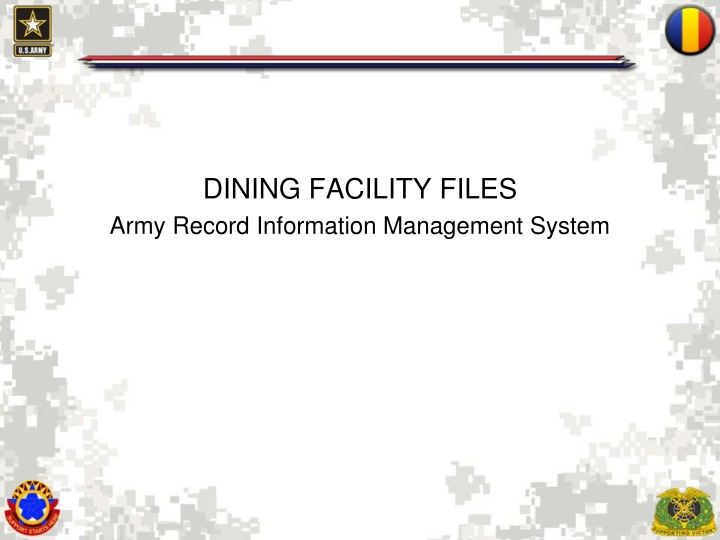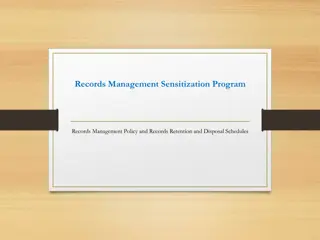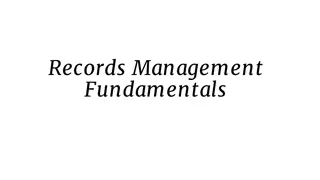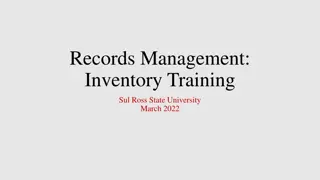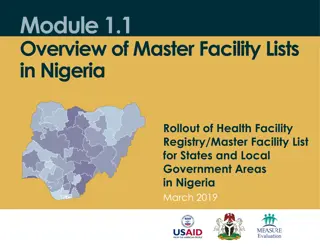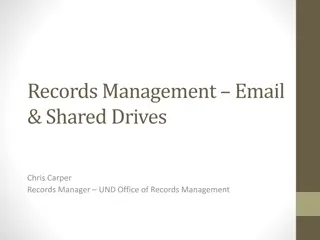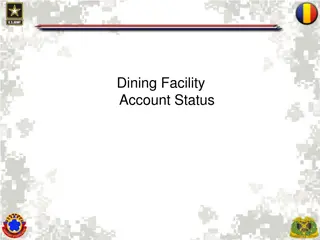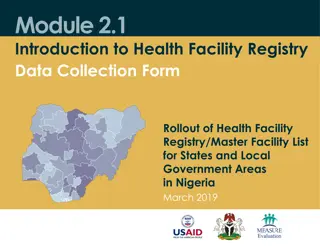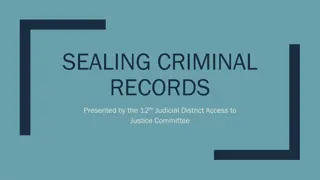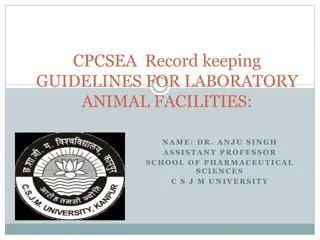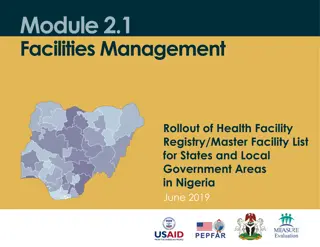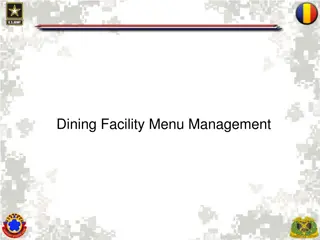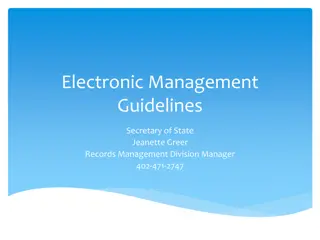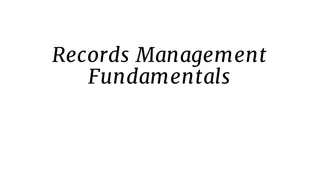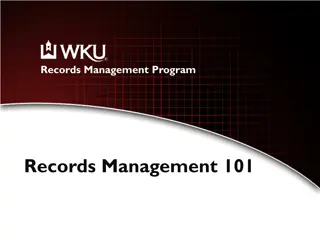Efficient Management of Dining Facility Records with ARIMS Guidelines
This content provides detailed information on the Army Record Information Management System (ARIMS) and its application in managing records at dining facilities. It covers areas such as ARIMS principles, filing guidance, labeling, and disposition of records. Understanding ARIMS helps dining facility managers maintain records effectively, follow proper retention schedules, and simplify recordkeeping processes.
Download Presentation

Please find below an Image/Link to download the presentation.
The content on the website is provided AS IS for your information and personal use only. It may not be sold, licensed, or shared on other websites without obtaining consent from the author.If you encounter any issues during the download, it is possible that the publisher has removed the file from their server.
You are allowed to download the files provided on this website for personal or commercial use, subject to the condition that they are used lawfully. All files are the property of their respective owners.
The content on the website is provided AS IS for your information and personal use only. It may not be sold, licensed, or shared on other websites without obtaining consent from the author.
E N D
Presentation Transcript
DINING FACILITY FILES Army Record Information Management System 1
Army Record Information Management System (ARIMS) To assist you in understanding ARIMS, we will discuss issues concerning the following areas: AR 25-400-2 (ARIMS). Areas in AR 25-400-2 (ARIMS) that the Dining Facility Manager and personnel responsible for records review, evaluation, and management should be familiar with to effectively setup and maintain records and files. Dining Facility Filing Guidance. Explanation and examples of effective files setup, file labeling, and files disposition. DA PAM 25-403. Guide to Record Keeping in the Army, this pamphlet provides operational procedures and guidelines for record keeping within the Army. It is to be used with AR 25-400-2. ARIMS Website. Familiarization https://www.arims.army.mil 2
ARIMS Principles of ARIMS ARIMS focuses on the management of long-term and permanent records and allows the business process (Management) to manage the short-term records. Simplifies recordkeeping. All records are categorized as two types. Short-term: No value beyond the business process. Long Term: For historical, lessons learned, audit purposes, or research. What does this mean to the dining facility? ARIMS only requires a minimum of information on short-term records for identification: this is the majority of the forms and AFMIS reports used in the dining facility. In short: Keep it simple. 3
ARIMS Labeling and Disposition An Example of the above is - The Kitchen Requisition and Returns Worksheet used by the shift during production. Once the information from this worksheet is entered into AFMIS and the Kitchen Requisition and Returns Report is printed, the worksheet can be disposed of. There is no business need to retain the worksheet. Disposition instructions are coded and begin with the letter K for keep or T for transfer, followed by an E for event when applicable. (i.e. KE, or TE). All K codes apply to short-term records that are kept according to the business process until no longer needed (or until no longer needed for business after an event occurs) not to exceed 6 years. The T codes apply to long-term (retentions over 6 years) and permanent records, with a few exceptions for records involving individual rights and interests. Disposition is applied by the servicing Records Holding Area (RHA) or the Army Electronic Archives to which records are transferred. Once the period of time is met the record should be destroyed 4
ARIMS Labeling and Disposition At a minimum, identification of the records should include a description of each record category, to indicate which are transfers (T) and which are keep (K) records. Retention periods for K records will be stated in the prescribing directive. The dining facility K record Retention schedule is found in DA Pam 30-22, paragraph 1-5 c which is the prescribing directive for dining facilities. 5
ARIMS DFAC Labeling As you can tell the new label is much more compact. It also seems like there is quite a bit less information on the new label. You will see that all the old information is still there, but in a new form. The K and the T refer you back to the guide folder (formerly referred to as the DUMMY folder) for all information about the file. Managers can add to these labels but this is the minimum requirement from ARIMS. The majority of information about the files is on the file guide. 6
ARIMS DFAC Labeling FILE IDENTIFICATION File guide labeling All required information on the label Folder labeling Only the information needed to identify and retrieve 7
ARIMS DFAC Labeling The Guide label should contain the information listed below: Privacy Act # N/A Event Driven No Production Schedules (1-15) Disposition Authority N1-AU-00-15 Additional Disposition Authority Record # 30-22d Record Type Keep Permanent Record No Duration 1 yr. Directive 30-22 Year Type FY09 Calendar Type NOV 08 8
ARIMS Container Labeling Filing cabinets or vehicles should be clearly labeled. Identify on labels contents of each file drawer or vehicle. Labels should correspond with file guides. Minimum information required. K: 6 MONTH ACTIVE FILES (FYXX) 30-22d Dining facility operations 30-22h Ration request, issue, delivery, and account status files 9
What is ARIMS? ARIMS is a system that provides the Army with the ability to manage hard copy and electronic records more efficiently and effectively. Using web-based tools and technology, ARIMS provides enhanced capabilities for the identification of records, the indexing and storage of long-term and permanent records, and the tracking and retrieval of records stored in the Army's Records Holding Area(s) (RHAs). 10
Major Changes Army Consolidated Records Schedule (ACRS) replaced Records Retention Schedule-Army (RRS-A) Consolidated 6000 records instructions Search options on website were reduced Disposition Codes (K-, T-, U-, S-, and R-Codes) were eliminated New retention periods (0-6 years, 6+ years, and Permanent) Office Records Lists (ORLs) were reduced (4-5 vs. 25-30) DA PAM 30-22 references RRS-A system and has not been updated. See para 1-5. 11
Other Important Information Food Service Files are 200D files. Food Service Files are kept under 3 periods Keep for 6 months after no longer needed Defined as a minimum of 6 months Active, then 6 months Inactive Keep for a year after no longer needed (NLN) Defined as a minimum of one year Active, then one year Inactive Keep for 6 years after NLN Defined as 6 Years When keeping files or documents in a separate location, ensure the location of the file/Doc is noted in the file. Example: If your SOP is on the shelf in a cabinet, have a memo in the file to show its location. 12
Army Consolidated Records Schedule Quick Reference Guide Navigate through the ARIMS Site to make labels. 13
Record Instructions Use the RRSA button next to the question mark to find what the disposition should be based off the old record instructions This will give you more specific guidance on how the file should be handled and what files go under what. 14
Use ARIMS to create your labels for your files and your container. Army Records Information Management System (ARIMS) User s Guide Version 3.5 15
Old Labels vs. New Labels K Dining facility operations NA Keep until NLN, NTE 6 YR, then destroy (04) OLD LABELs K 30-22d Dining facility operations (04) NA Keep until NLN, NTE 6 YR, then destroy 6 MO ACTIVE/ 6 MO INACTIVE 200D DA Form 3034 OCT (1-15) (2012) PA:NA Destroy in CFA 0.50 years after NLN NEW LABELs 200D Production Schedules OCT (1st through 15th) (2012) 6 MO INACTIVE PA:NA Keep until NLN then destroy after 6 Months 16
ARIMS DFAC Disposition All documents and file records related to Army garrison food service, the Army field feeding system, and troop issue support activity operations are maintained and disposed of in accordance with AR 25-400-2, Army Records Information Management System (ARIMS). For the purpose of the Army Food Program, no longer needed for conducting business is defined as a minimum of six months active, then six months inactive for all Keep (K) category records with no events and with assigned records retention duration of zero, with the following exceptions: 1) For ARIMS records labeled K no longer needed for conducting business is defined as a minimum of one year active, then one year inactive . 2) For ARIMS records Labeled T, no longer needed for conducting business is defined as six years . 17
ARIMS and DFAC All Transfer (T) category records will use the ARIMS Records Retention Schedule, Army (RRS-A) for records dispositions. Transfer (T) category records with a disposition of no longer needed for conducting business will be managed as follows: 1) For records with a scheduled retention period of two or more years will be held in the Current Files Area (CFA) for a minimum of two years. Review records annually. 2) Records that have met the required 2 year requirement and are determined to be no longer needed for conducting business will be transferred to the Records Holding Area (RHA). If a K record it can be destroyed. 3) When a DA Form 3032 is used as a deferred payment vehicle (generally in emergency situations) it will be maintained in the same manner as DD Form 1544 (ARIMS record number 30-22a). 18
ARIMS DFAC Disposition File Organization. 6 month active and 6 month inactive files should be grouped for ease of review, retrieval, and management of records. This means: Fiscal Year files and Calendar files are combined into two separate groups, they are: a) Group 1-FY Files: 1 October through 31 March. b) Group 2-FY Files: 1 April through 30 September. c) Group 1-CY Files: 1 January through 30 June. d) Group 2-CY Files: 1 July through 31 December. How it works and why: 1) Let s say we are starting a new fiscal year on 1 October, 2006 (07- Fiscal Year ) and will need to file our 6 month reports for October, November, December, and so forth. Our first set, or group, of records will be 6 month active records and filed in the 6 month active file drawer: as a group. Once the last report dated 31 March, 2007 (07-Fiscal Year) is filed, the entire group of records will move to and become the 6 month inactive files. 2) Files created and beginning 1 April, 2007 now become the 6 month active files. Once the last file dated 30 September, 2007 (still a 07 Fiscal Year file) is filed, this group of records will move to and replace the previous 6 month inactive files dated 1 October, 2007 through 31 March, 2008. Files are rotated as a group in this manner for ease of management. 3) Records that have reached the end of their 1 year inactive period are now considered no longer needed for conducting business and can be disposed of IAW AR 25-400-2, Chapter 7-4, Records Disposal. 19
ARIMS Guide to Army Record Keeping Dated 11 August 2008. Should be used in conjunction with AR 25-400-2 Describes functions of the records administrator, records manager, record coordinator, and service manager. Appointment orders necessary for all above stated functions. Dining facility administration NCOIC would be the records coordinator for the unit (DFAC). Helps to simplify use of the regulation. 20
ARIMS Website ARIMS website https://www.arims.army.mil Records management tools - records retention schedules - create office records list (ORL) - print file labels A great tool to learn Utilize as needed i.e. file labels, RRS, ORL s 21
DINING FACILITY FILES MANAGEMENT ? 22
